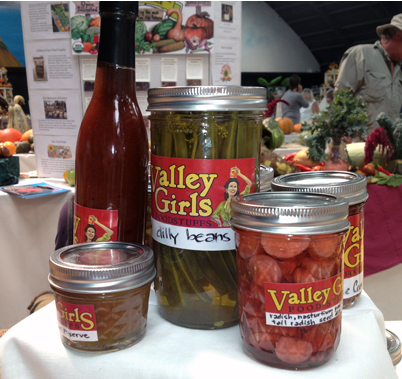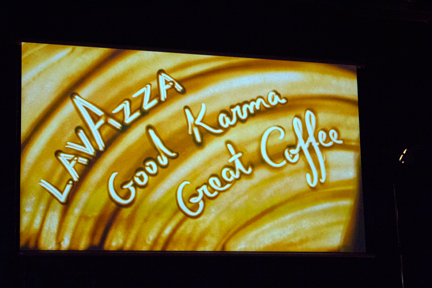In Her Own Words, Why a Social Business
 I'm pleased to have Anea Botton, founder of Valley Girls Foodstuffs as a guest blogger today. Welcome, Anea!
I met Anea at The 2nd Annual National Heirloom Festival where we both were vendors. I loved her red glasses, her brand image, and once I got to know her and the folks from Valley Girls Foodstuffs, I was very impressed with them and their mission. Since the expos, a lot of great things are happening for them, and I'm sure there will be more updates as they grow.
I'm pleased to have Anea Botton, founder of Valley Girls Foodstuffs as a guest blogger today. Welcome, Anea!
I met Anea at The 2nd Annual National Heirloom Festival where we both were vendors. I loved her red glasses, her brand image, and once I got to know her and the folks from Valley Girls Foodstuffs, I was very impressed with them and their mission. Since the expos, a lot of great things are happening for them, and I'm sure there will be more updates as they grow.
I thought that a personal account of why an entrepreneur would choose to build a local business with a social purpose would be a good compliment to the recent three-part series about Lavazza, an international company working with a social purpose on a global scale. Anea was kind enough to agree to my request to write this post, and here is what Anea has to say, in her own words.
Sometimes we do things because we feel called to them. Sometimes we do things because we just plain like doing them. And sometimes we do things because we can’t imagine NOT doing them.
Valley Girls Foodstuffs has a little of all of those things bundled up in its origin. Since 2009 I have volunteered at the Valley of the Moon Teen Center, part of a non-profit in Sonoma that offers life skills programming. I’ve been a business owner since 2008 in this small town where I live and grew up when I opened my own insurance agency. In 2009, I wanted to be more involved in my community somehow, and I fell into cooking dinner once a week to a mostly Hispanic population of teens at the teen center. The mother of a toddler, I didn’t have much experience being around teens, and the Hispanic teens at this location brought with them the requisite practiced bravado and unwitting innocence that I remembered from my own days as a teenager. But this group had a particular air of something else I couldn’t put a finger on. And I didn’t realize what it was until I’d spent some time being around the kids.
When you see people who live in conditions you yourself have never experienced, it’s hard to know what, exactly, you are dealing with. There were so many stories, big and small things, and they began to coalesce into an understanding of what it means for kids to be “at risk.” It’s so many things - financial hardship, family issues, lack of education. It’s one or a combination of those things. And for the harder hit, the ones with parents who are missing for one reason or another, the deck seems to be stacked exponentially against them. I’m not a social worker and I have no background in social reform. I only know the things I’ve seen working with and around these kids.
Some of the kids come from really large families with 6 or 8 kids living in 3 bedroom houses, loving homes of limited means. These kids have a strong sense of family and tend to stay out of trouble, do well in school, and not affiliate with a gang. But they have little money and few skills. They go to the teen center after school mostly to partake in the life skills programs offered there, to socialize and to eat food they don’t have to share with siblings.
More kids have bigger problems. I saw a 16-year old boy (who had 2 jobs while going to high school, with a live-in girlfriend and a baby girl at home) get beat up in front of the teen center one afternoon. My heart skipped several beats and I froze while the director of the teen center, a woman, chased away his assailants and picked him and his glasses up off the ground in front of the teen center. The director told me later it was all over his “color.” I thought she meant his skin; he looked no different than any of the other kids. She had to explain she meant gang colors. And there was the time I overheard a young girl crying, whispering about how the night before her mother and aunt had dragged her by her hair down the street where she lived because of something she’d done. A few weeks later I learned she was in foster care in another town, trying to figure out how to get back to Sonoma to see her boyfriend. And there was the boy who had to pick up his dad from bars at night, the father drunk and railing in Spanish, while his son held him up and walked him home. And the girl whose dad was in prison and whose mother had been through a series of boyfriends, men who it was rumored had touched her in ways that we call inappropriate. None of these kids are angels; they often use foul language and posture in ways that looked ridiculous to me. But they are kids and it makes me wonder what my life would be had I been exposed to even a fraction of what they deal with daily.
I look at many of the kids at the teen center and I know I can never fully understand their situation. I’m not going to change their world and I probably won’t change many of their lives in a huge way. But I can still do something, and that something is Valley Girls Foodstuffs. While it is a new and small business, it attempts to address a piece of the at-risk culture in my hometown by employing some of the kids I met while volunteering at the teen center. I teach them preserving skills like canning, drying and fermenting as well as baking. We use surplus and “less than perfect” produce that would normally be passed over by more aesthetically inclined shoppers, but which is perfect for preservation. I am not making enough money yet to cover all of our costs, but I didn’t expect to, not so soon. And while we cook, we talk about food system issues, we talk about business, we talk about our lives.
One of the things I have seen in founding a food business with a social purpose is that I must carefully consider each decision and weigh it not only on its merits from a business perspective but also on its merits within a food and social equity context. I am not building the next cell phone app nor creating a singular food product that fills a niche market. The kids are learning usable skills, they create a plethora of delicious products from produce people might otherwise let go to waste and they get paid for the work they do. They are learning how to run a for-profit business when most people might go the non-profit route because I believe it’s important to teach kids the benefits of working for their money so they don’t have to live in a manner that leaves them beholden to anyone.
Sometimes we do things because we feel called to them. Sometimes we do things because we just plain like doing them. And now that Valley Girls Foodstuffs is up and running, I just couldn’t imagine NOT doing it.

